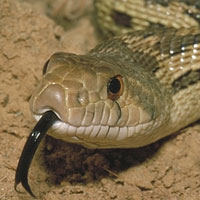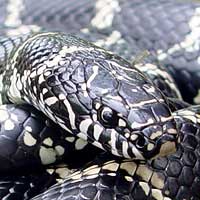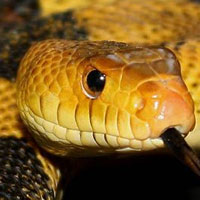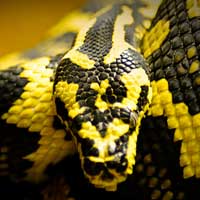Everything You Need to Know About Lataste's Viper
Lataste's Viper, scientifically known as Vipera latastei, belongs to the Viperidae snake family, which is characterized by its venomous species equipped with long, hinged fangs and heat-sensing pits, making it a highly efficient predator native to the Mediterranean regions of southwestern Europe and northern Africa.
Scientific Name: Vipera latastei
Snake Family: Viperidae
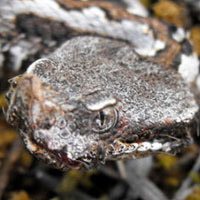
An Overview of Lataste's Viper
Lataste's Viper (Vipera latastei) is a small yet venomous snake native to parts of southwestern Europe and northern Africa. Named after the French herpetologist Fernand Lataste, this viper is easily recognized by its triangular head, stout body, and distinctive zigzag pattern running along its back. Despite its venomous bite, Lataste's Viper is a shy species that prefers avoiding human interaction and plays an essential role in maintaining the ecological balance by controlling rodent populations in its native habitats.
Where Does Lataste's Viper Live?
Lataste's Viper thrives in a variety of environments across its geographic range. Key habitat characteristics include:
- Geographic Range: Found in southwestern Europe, including Spain and Portugal, as well as northern Africa, particularly in Morocco and Algeria.
- Preferred Environments: Rocky terrains, scrublands, Mediterranean woodlands, and areas with dense vegetation.
- Climate: Adapts well to dry, warm climates typical of Mediterranean regions but is also found in cooler, higher-altitude areas.
Lataste's Viper often seeks shelter under rocks, within crevices, or beneath dense vegetation, making these features critical for its survival. Agricultural landscapes, though less ideal, are sometimes used by these snakes when natural habitats are disturbed. Below is a summary of its habitat preferences:
| Habitat Feature | Description |
|---|---|
| Geographic Range | Southwestern Europe, northern Africa |
| Preferred Terrain | Rocky areas, scrublands |
| Climate | Mediterranean, warm and dry |
What Does Lataste's Viper Eat?
Lataste's Viper is a carnivorous predator that relies on ambush tactics to capture its prey. Key dietary details include:
- Primary Prey: Small mammals such as mice, voles, and shrews.
- Occasional Prey: Lizards, amphibians, and small birds, particularly in areas where rodents are scarce.
- Hunting Strategy: Remains motionless, camouflaged within its surroundings, until prey comes within striking distance. It then delivers a quick venomous bite to immobilize the target.
This dietary flexibility enables Lataste's Viper to thrive in diverse environments and cope with fluctuating prey availability. By controlling rodent populations, this snake plays a critical role in maintaining ecological balance, especially in areas prone to agricultural pests.
Understanding the Behavior of Lataste's Viper
Lataste's Viper exhibits several interesting behavioral traits that contribute to its survival in challenging environments. Key traits include:
- Activity Patterns: Primarily crepuscular, with peak activity during dawn and dusk to avoid extreme temperatures and predators.
- Defensive Behavior: Relies on camouflage to avoid detection, but will hiss and strike if provoked or threatened.
- Social Behavior: Solitary, except during mating season, when males may compete for access to females.
Despite its venomous reputation, Lataste's Viper is generally shy and will retreat if given the opportunity. Understanding its behavior is crucial for safely coexisting with this species in shared habitats.
Health and Lifespan of Lataste's Viper
Lataste's Viper is a resilient species with a relatively long lifespan. Important health considerations include:
- Lifespan: 10-15 years in the wild, with individuals in captivity living longer under optimal care.
- Health Risks: Habitat destruction, climate change, and human activity are the primary threats to its populations.
- Predators: Birds of prey, larger reptiles, and mammals such as foxes and wildcats pose significant risks, especially to juveniles.
Efforts to preserve its natural habitats and reduce human-wildlife conflict are essential for ensuring the long-term survival of Lataste's Viper.
How Does Lataste's Viper Reproduce?
The reproductive cycle of Lataste's Viper is well-adapted to its environment. Key details include:
- Mating Season: Typically occurs in spring, coinciding with warmer weather and increased prey availability.
- Reproductive Method: Ovoviviparous, meaning females give birth to live young rather than laying eggs.
- Litter Size: Usually produces 4-12 offspring, depending on the female’s size and health.
- Hatchling Behavior: Newborns are fully venomous and independent, capable of hunting small prey immediately after birth.
The timing of reproduction and high survival instincts of the hatchlings ensure the continuation of Lataste's Viper populations, even in challenging conditions.
Safety Guidelines for Handling Lataste's Viper
Handling Lataste's Viper requires specialized training and precautions. Essential safety measures include:
- Always use professional tools such as snake hooks and secure transport containers.
- Wear protective gloves and boots to minimize the risk of envenomation.
- Ensure enclosures replicate the snake’s natural habitat and are escape-proof.
- Keep antivenom readily available and have an emergency protocol in place.
Only trained professionals should attempt to handle this species. Public education about its ecological importance and proper safety measures can help reduce negative encounters with Lataste's Viper in its native range.
Disclaimer
The information provided in this article is for educational purposes only. SnakeEstate strongly advises against handling or interacting with venomous snakes, such as Lataste's Viper, unless you are a trained and licensed professional. These snakes pose significant risks, and improper handling can result in serious injury or death. Always adhere to local regulations and prioritize safety when dealing with wildlife.
Other Snakes In This Species
 Asp Viper
Asp Viper Black Mamba
Black Mamba Boomslang
Boomslang Brazilian Coral Snake
Brazilian Coral Snake Bushmaster
Bushmaster Coastal Taipan
Coastal Taipan Common Death Adder
Common Death Adder Common European Adder
Common European Adder Copperhead
Copperhead Coral Snake
Coral Snake Cottonmouth
Cottonmouth Eastern Brown Snake
Eastern Brown Snake Eastern Diamondback Rattlesnake
Eastern Diamondback Rattlesnake Egyptian Cobra
Egyptian Cobra Fer-de-lance
Fer-de-lance Forest Cobra
Forest Cobra Indian Cobra
Indian Cobra Inland Taipan
Inland Taipan Jameson’s Mamba
Jameson’s Mamba King Cobra
King Cobra Lancehead
Lancehead Lataste’s Viper
Lataste’s Viper Malayan Krait
Malayan Krait Mojave Rattlesnake
Mojave Rattlesnake New Guinea Small-eyed Snake
New Guinea Small-eyed Snake Nose-horned Viper
Nose-horned Viper Puff Adder
Puff Adder Russell’s Viper
Russell’s Viper Saw-scaled Viper
Saw-scaled Viper Solomon Island Coral Snake
Solomon Island Coral Snake South American Rattlesnake
South American Rattlesnake Tiger Snake
Tiger Snake Western Diamondback Rattlesnake
Western Diamondback Rattlesnake



